New Changes in Chinese Urban Tourism Pattern under the Impact of COVID-19 Pandemic: Based on Internet Attention
Abstract
:1. Introduction
2. Literature Review
3. Materials and Methods
3.1. Research Area
3.2. Data Source
3.3. Research Methodology
3.4. Research Framework
4. Results
4.1. Overall Change Characteristics of Changes in Internet Attention
4.2. Tourism Element Characteristics of Changes in Internet Attention
4.3. Tourist Attraction Characteristics of Changes in Internet Attention
5. Discussion
5.1. Analysis of Driving Mechanism
5.2. Limitations
6. Conclusions and Recommendations
6.1. Conclusions
6.2. Recommendations
Author Contributions
Funding
Institutional Review Board Statement
Informed Consent Statement
Data Availability Statement
Conflicts of Interest
References
- Wang, C.; Meng, X.; Siriwardana, M.; Pham, T. The impact of COVID-19 on the Chinese tourism industry. Tour. Econ. 2022, 28, 131–152. [Google Scholar] [CrossRef]
- Niewiadomski, P. COVID-19: From temporary de-globalisation to a re-discovery of tourism? Tour. Geogr. 2020, 22, 651–656. [Google Scholar] [CrossRef]
- Lapointe, D. Reconnecting tourism after COVID-19: The paradox of alterity in tourism areas. Tour. Geogr. 2020, 22, 633–638. [Google Scholar] [CrossRef]
- Pan, B. The power of search engine ranking for tourist destinations. Tour. Manag. 2015, 47, 79–87. [Google Scholar] [CrossRef]
- Ruan, W.; Li, Y. The Impact and Spatial Difference of Natural Disaster Crisis on Tourist Demand. Econ. Geogr. 2018, 38, 214–223. [Google Scholar] [CrossRef]
- Bangwayo-Skeete, F.P.; Skeete, W.R. Can Google data improve the forecasting performance of tourist arrivals? Mixed-data sampling approach. Tour. Manag. 2015, 46, 454–464. [Google Scholar] [CrossRef]
- Xin, L.; Law, R. Forecasting tourism demand with decomposed search cycles. J. Travel. Res. 2020, 59, 52–68. [Google Scholar] [CrossRef]
- Huang, X.; Zhang, L.; Ding, Y. The Baidu Index: Uses in predicting tourism flows–A case study of the Forbidden City. Tour. Manag. 2017, 58, 301–306. [Google Scholar] [CrossRef]
- Li, S.; Chen, T.; Wang, L.; Ming, C. Effective tourist volume forecasting supported by PCA and improved BPNN using Baidu index. Tour. Manag. 2018, 68, 116–126. [Google Scholar] [CrossRef]
- Yang, X.; Pan, B.; Evans, J.A.; Lv, B. Forecasting Chinese tourist volume with search engine data. Tour. Manag. 2015, 46, 386–397. [Google Scholar] [CrossRef]
- Li, H.; Hu, M.; Li, G. Forecasting tourism demand with multisource big data. Ann. Tour. Res. 2020, 83, 102912. [Google Scholar] [CrossRef]
- Li, X.; Pan, B.; Law, R.; Huang, X. Forecasting tourism demand with composite search index. Tour. Manag. 2017, 59, 57–66. [Google Scholar] [CrossRef]
- Wang, Y.; Xi, M.; Chen, H.; Lu, C. Evolution and driving mechanism of tourism flow networks in the Yangtze River Delta urban agglomeration based on social network analysis and geographic information system: A double-network perspective. Sustainability 2022, 14, 7656. [Google Scholar] [CrossRef]
- Li, Y.; Gong, G.; Zhang, F. Network Structure Features and Influencing Factors of Tourism Flow in Rural Areas: Evidence from China. Sustainability 2022, 14, 9623. [Google Scholar] [CrossRef]
- Wang, K.; Guo, F.; Li, R.; Fu, X. International attention and spatial pattern of Chinese tourist destinations based on Tripadvisor. Prog. Geogr. 2014, 33, 1462–1473. [Google Scholar] [CrossRef]
- Jing, E.; Guo, F.; Li, R.; Zhang, J.; Fu, X. Research on the network attention of Hebei A-level scenic spots based on Sina Travel Blog. Geogr. Geo-Inf. Sci. 2015, 31, 118–122. [Google Scholar]
- Lim, C.; Min, J.C.; McAleer, M. Modelling income effects on long and short haul international travel from Japan. Tour. Manag. 2008, 29, 1099–1109. [Google Scholar] [CrossRef]
- Mao, C.K.; Ding, C.G.; Lee, H.Y. Post-SARS tourist arrival recovery patterns: An analysis based on a catastrophe theory. Tour. Manag. 2010, 31, 855–861. [Google Scholar] [CrossRef] [PubMed]
- Gang, X.; Gennian, S. Post-Evaluation of SARS in 2003 on Domestic Tourism in China: Loss Estimation in 31 Provinces Based on Background Trend Line. Econ. Geogr. 2008, 28, 1059–1063. [Google Scholar]
- Rahman, F.; Halim, N.A.; Ahad, A.; Alam, A.; Noor, K. Local Economic Impact of COVID-19 on the Urban Tourism-Related Services: A Perspective of Kochi Heritage City, Kerala. Sustainability 2023, 15, 16585. [Google Scholar] [CrossRef]
- Duro, J.A.; Perez-Laborda, A.; Turrion-Prats, J.; Fernández-Fernández, M. COVID-19 and tourism vulnerability. Tour. Manag. Perspect. 2021, 38, 100819. [Google Scholar] [CrossRef] [PubMed]
- Tuzová, K.; Vaishar, A.; Šťastná, M.; Urbanová, M. The Impacts of COVID-19 on the Visitor Attendance of Cultural and Natural Heritage: A Case Study of the South Moravian Region. Sustainability 2023, 15, 14081. [Google Scholar] [CrossRef]
- Huang, S.S.; Shao, Y.; Zeng, Y.; Liu, X.; Li, Z. Impacts of COVID-19 on Chinese nationals’ tourism preferences. Tour. Manag. Perspect. 2021, 40, 100895. [Google Scholar] [CrossRef] [PubMed]
- Ivanova, M.; Ivanov, I.K.; Ivanov, S. Travel behaviour after the pandemic: The case of Bulgaria. Anatolia 2021, 32, 1–11. [Google Scholar] [CrossRef]
- Jeong, J.Y.; Crompton, J.L.; Lee, K.Y. Applying the TRIRISK model to COVID-19 in tourism: A comparison between 2020 and 2021. Tour. Manag. Perspect. 2022, 41, 100936. [Google Scholar] [CrossRef]
- Zhang, S.; Sun, T.; Lu, Y. The COVID-19 pandemic and tourists’ risk perceptions: Tourism policies’ mediating role in sustainable and resilient recovery in the New Normal. Sustainability 2023, 15, 1323. [Google Scholar] [CrossRef]
- Zawadka, J.; Uglis, J.; Kozera-Kowalska, M.; Jęczmyk, A.; Pietrzak-Zawadka, J.; Wojcieszak-Zbierska, M.M. An Empirical Assessment of Students’ Tourist Preferences during the COVID-19 Pandemic from a Gender Perspective: Evidence from Poland. Sustainability 2023, 15, 14346. [Google Scholar] [CrossRef]
- Boto-García, D.; Mayor, M. Domestic tourism and the resilience of hotel demand. Ann. Tour. Res. 2022, 93, 103352. [Google Scholar] [CrossRef]
- Li, L.; Liu, S.; Li, C.; Zhang, P.; Lo, K. What matters for regional economic resilience amid multi shock situations: Structural or agency? Evidence from resource-based cities in China. Sustainability 2022, 14, 5701. [Google Scholar] [CrossRef]
- Duro, J.A.; Osorio, A.; Perez-Laborda, A.; Fernández-Fernández, M. Measuring tourism markets vulnerability across destinations using composite indexes. J. Destin. Mark. Manag. 2022, 25, 100731. [Google Scholar] [CrossRef]
- Zhao, C.; Yang, Y.; Wu, S.; Wu, W.; Xue, H.; An, K.; Zhen, Q. Search trends and prediction of human brucellosis using Baidu index data from 2011 to 2018 in China. Sci. Rep. 2020, 10, 5896. [Google Scholar] [CrossRef] [PubMed]
- Wang, Z.; He, J.; Ji, B.; Zhang, L.; Han, C.; Wang, M.; Wang, H.; An, S.; Zhao, M.; Zhen, Q. Using Baidu Index Data to Improve Chickenpox Surveillance in Yunnan, China: Infodemiology Study. J. Med. Internet Res. 2023, 25, 44186. [Google Scholar] [CrossRef] [PubMed]
- Liu, K.; Wang, T.; Yang, Z.; Huang, X.; Milinovich, G.J.; Lu, Y.; Jing, Q.; Xia, Y.; Zhao, Z.; Yang, Y.; et al. Using Baidu search index to predict dengue outbreak in China. Sci. Rep. 2016, 6, 38040. [Google Scholar] [CrossRef] [PubMed]
- Aaronson, D.; Brave, S.A.; Butters, R.A.; Fogarty, M.; Sacks, D.W.; Seo, B. Forecasting unemployment insurance claims in realtime with Google Trends. Int. J. Forecast. 2022, 38, 567–581. [Google Scholar] [CrossRef]
- Flanagan, R.; Kuo, B.; Staller, K. Utilizing Google Trends to assess worldwide interest in irritable bowel syndrome and commonly associated treatments. Dig. Dis. Sci. 2021, 66, 814–822. [Google Scholar] [CrossRef] [PubMed]
- Bansal, A.; Gupta, S.; Jain, V.; Kumar, A.; Klein, A. Utilizing Google trends to assess worldwide interest in COVID-19 and myocarditis. J. Med. Syst. 2021, 45, 1–2. [Google Scholar] [CrossRef] [PubMed]
- Jiao, S.; Li, M.; Tian, F. Distribution Pattern and Driving Mechanism of Network Attention of Chinese Red Tourism Classic Scenic Spots. Econ. Geogr. 2022, 42, 211–220. [Google Scholar] [CrossRef]
- Fang, Y.; Cheng, X.; Huang, Z. The Dislocation Characteristics and Mechanism of Network Attention and Tourists about Chinese National Scenic Spots. Econ. Geogr. 2020, 40, 204–213. [Google Scholar] [CrossRef]
- Xue, C.H.; Bai, Y. Spatiotemporal Characteristics and Factors Influencing Urban Tourism Market Network in Western China: Taking Chengdu as an Example. Sustainability 2023, 15, 8135. [Google Scholar] [CrossRef]
- Zhang, G.; Yuan, H. Spatio-temporal evolution characteristics and spatial differences in urban tourism network attention in China: Based on the Baidu index. Sustainability 2022, 14, 13252. [Google Scholar] [CrossRef]
- Pan, B.; Chenguang Wu, D.; Song, H. Forecasting hotel room demand using search engine data. J. Hosp. Tour. Technol. 2012, 3, 196–210. [Google Scholar] [CrossRef]
- Wen, L.; Liu, C.; Song, H.; Liu, H. Forecasting tourism demand with an improved mixed data sampling model. J. Travel. Res. 2021, 60, 336–353. [Google Scholar] [CrossRef]
- Park, S.; Lee, J.; Song, W. Short-term forecasting of Japanese tourist inflow to South Korea using Google trends data. J. Travel. Tour. Mark. 2017, 34, 357–368. [Google Scholar] [CrossRef]
- Dergiades, T.; Mavragani, E.; Pan, B. Google Trends and tourists’ arrivals: Emerging biases and proposed corrections. Tour. Manag. 2018, 66, 108–120. [Google Scholar] [CrossRef]
- Hou, X. Tourism Network Attention Variation of Chinese Cities under the COVID-19 Pandemic. Sustainability 2022, 14, 5131. [Google Scholar] [CrossRef]
- Wang, Q.; Liu, Y.; Li, X. Evolution characteristics of 24 major cities’ network attention degree of six elements of tourism in China. World Reg. Stud. 2017, 26, 45–55. [Google Scholar] [CrossRef]
- Shi, J.; Gao, X.; Xue, S.; Li, F.; Nie, Q.; Lv, Y.; Wang, J.; Xu, T.; Du, G.; Li, G. Spatio-temporal evolution and influencing mechanism of the COVID-19 epidemic in Shandong province, China. Sci. Rep. 2021, 11, 7811. [Google Scholar] [CrossRef] [PubMed]
- Zhang, L.; Liu, Y. Generalization of Tourisms Sciences; Beijing Normal University Publishing Group: Beijing, China, 2013. [Google Scholar]
- Bao, J.; Yang, M.; Weng, H. Development of Tourism Geography as a Discipline in China. Econ. Geogr. 2021, 41, 79–86. [Google Scholar] [CrossRef]
- Xu, H.; Zhu, D.; Bao, J. Sustainability and nature-based mass tourism: Lessons from China’s approach to the Huangshan Scenic Park. J. Sustain. Tour. 2016, 24, 182–202. [Google Scholar] [CrossRef]
- Sun, G. Foundation and Significance of Background Trend Line of Tourists from Abroad in China. Econ. Geogr. 1998, 5, 51–57. [Google Scholar]
- Wang, Q.; Mei, L.; Jiang, H. Spatio-temporal Differentiation and Influencing Factors of Star-rated Hotels’ Resilience of China’s Tourism Cities. Sci. Geogr. Sin. 2022, 42, 1483–1491. [Google Scholar] [CrossRef]
- Prayag, G.; Ryan, C. The relationship between the ‘push’ and ‘pull’ factors of a tourist destination: The role of nationality–an analytical qualitative research approach. Curr. Issues Tour. 2011, 14, 121–143. [Google Scholar] [CrossRef]
- Volchek, K.; Liu, A.; Song, H.; Buhalis, D. Forecasting tourist arrivals at attractions: Search engine empowered methodologies. Tour. Econ. 2019, 25, 425–447. [Google Scholar] [CrossRef]
- Höpken, W.; Eberle, T.; Fuchs, M.; Lexhagen, M. Improving tourist arrival prediction: A big data and artificial neural network approach. J. Travel. Res. 2021, 60, 998–1017. [Google Scholar] [CrossRef]
- Chen, X.; Xia, E.; He, T. Influence of traveller risk perception on the willingness to travel in a major epidemic. Int. J. Sustain. Dev. Plan. 2020, 15, 901–909. [Google Scholar] [CrossRef]
- Aziz, N.A.; Long, F. To travel, or not to travel? The impacts of travel constraints and perceived travel risk on travel intention among Malaysian tourists amid the COVID-19. J. Consum. Behav. 2022, 21, 352–362. [Google Scholar] [CrossRef] [PubMed]
- Wang, X.; Wang, M.; Lu, X.; Guo, L.; Zhao, R.; Ji, R. Spatio-temporal evolution and driving factors of the high-quality development of provincial tourism in China. Chin. Geogr. Sci. 2022, 32, 896–914. [Google Scholar] [CrossRef]
- Liu, Y.; Han, Y. Factor structure, institutional environment and high-quality development of the tourism economy in China. Tour. Trib. 2020, 35, 28–38. [Google Scholar] [CrossRef]
- Gao, Y.; Sun, D.; Zhang, J. Study on the impact of the COVID-19 pandemic on the spatial behavior of urban tourists based on commentary big data: A case study of Nanjing, China. ISPRS Int. J. Geo-Inf. 2021, 10, 678. [Google Scholar] [CrossRef]

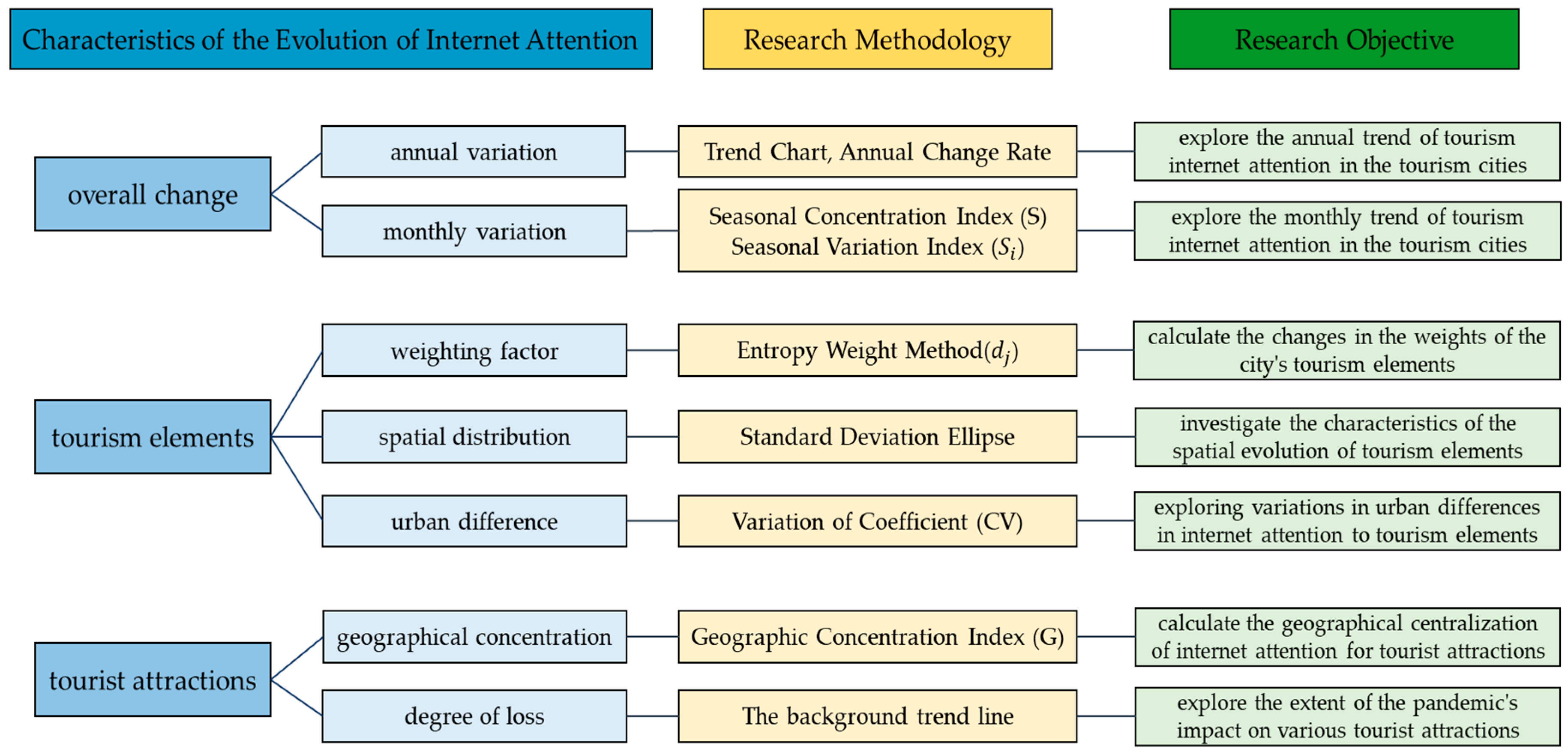


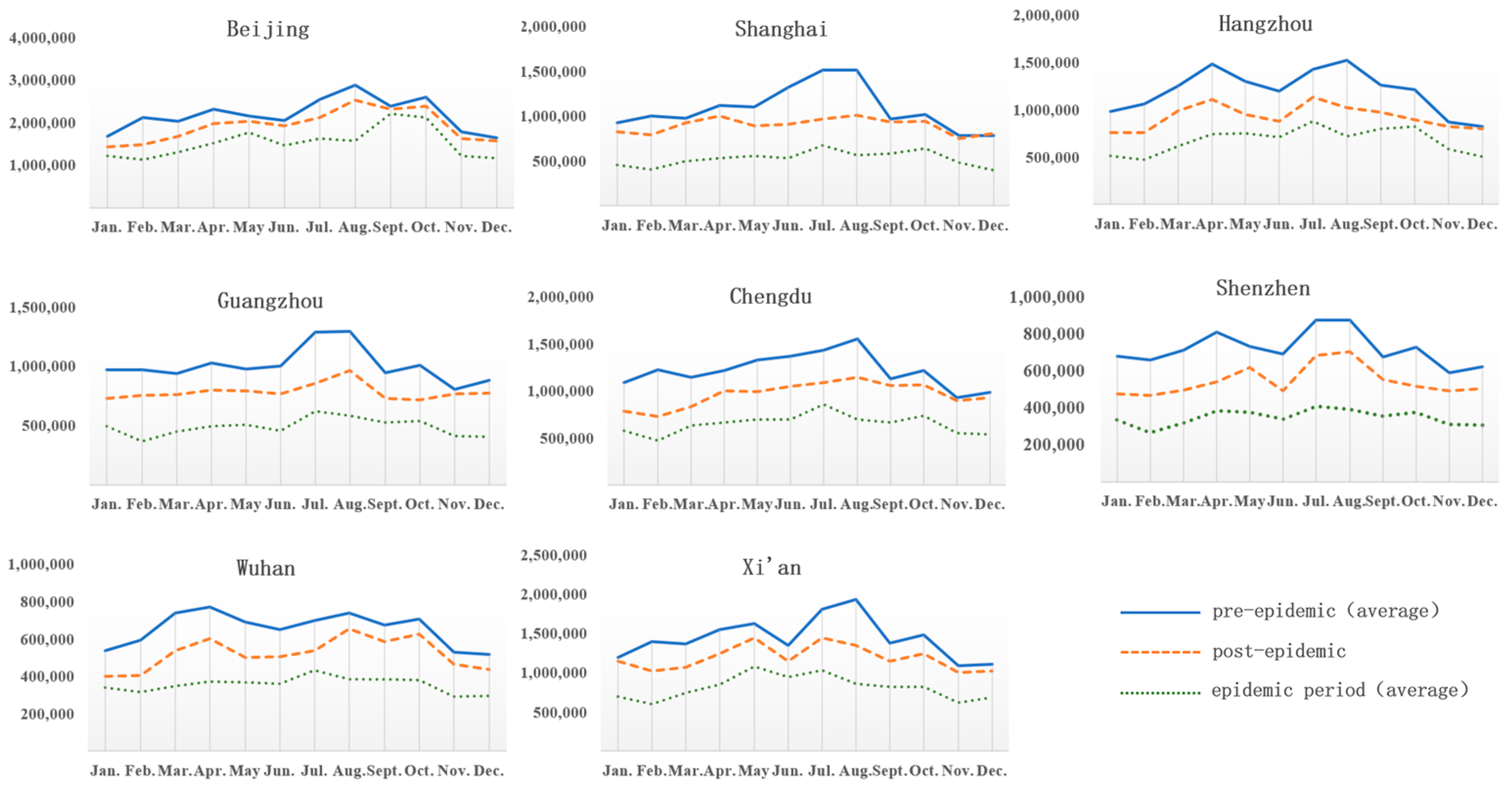
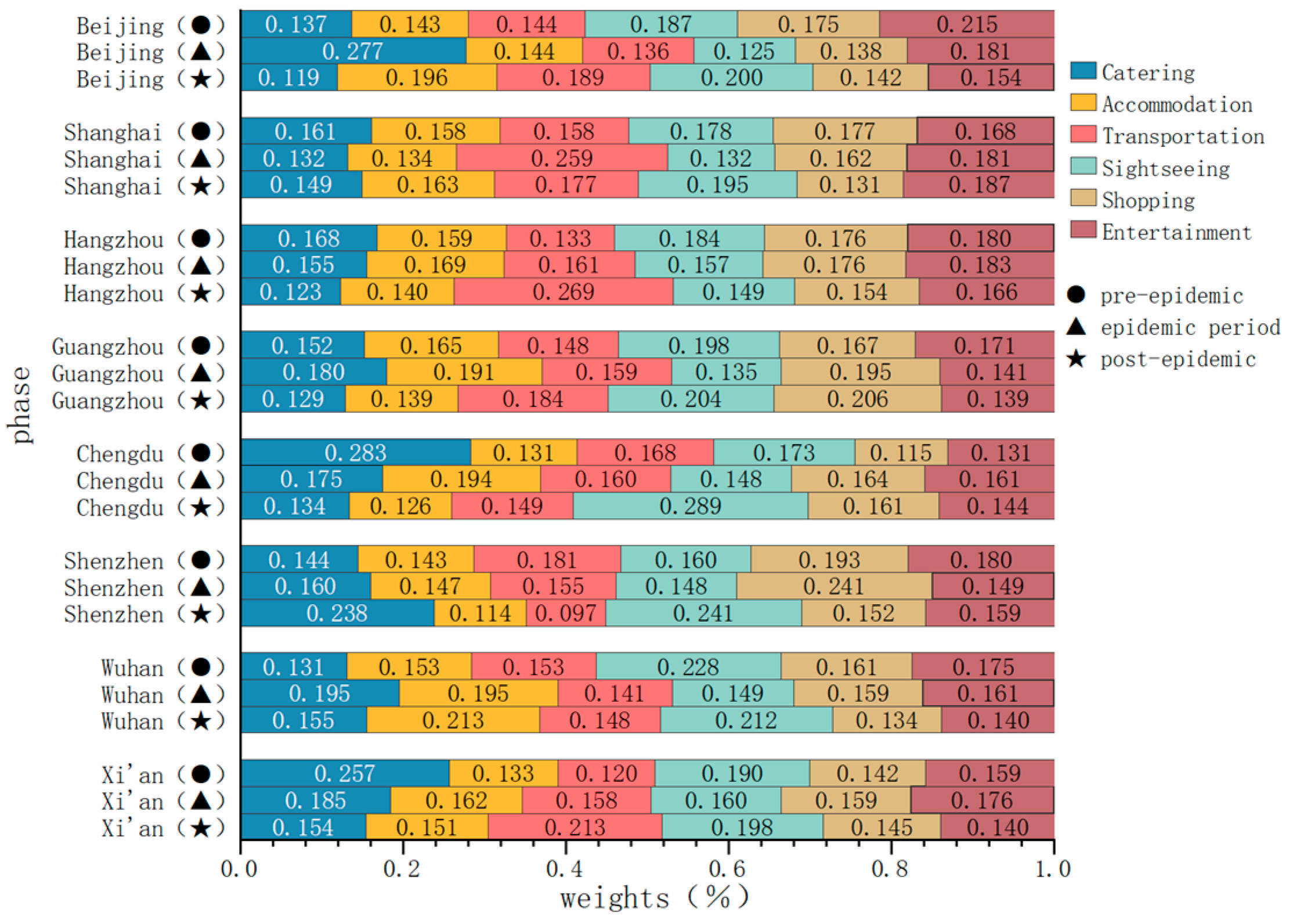


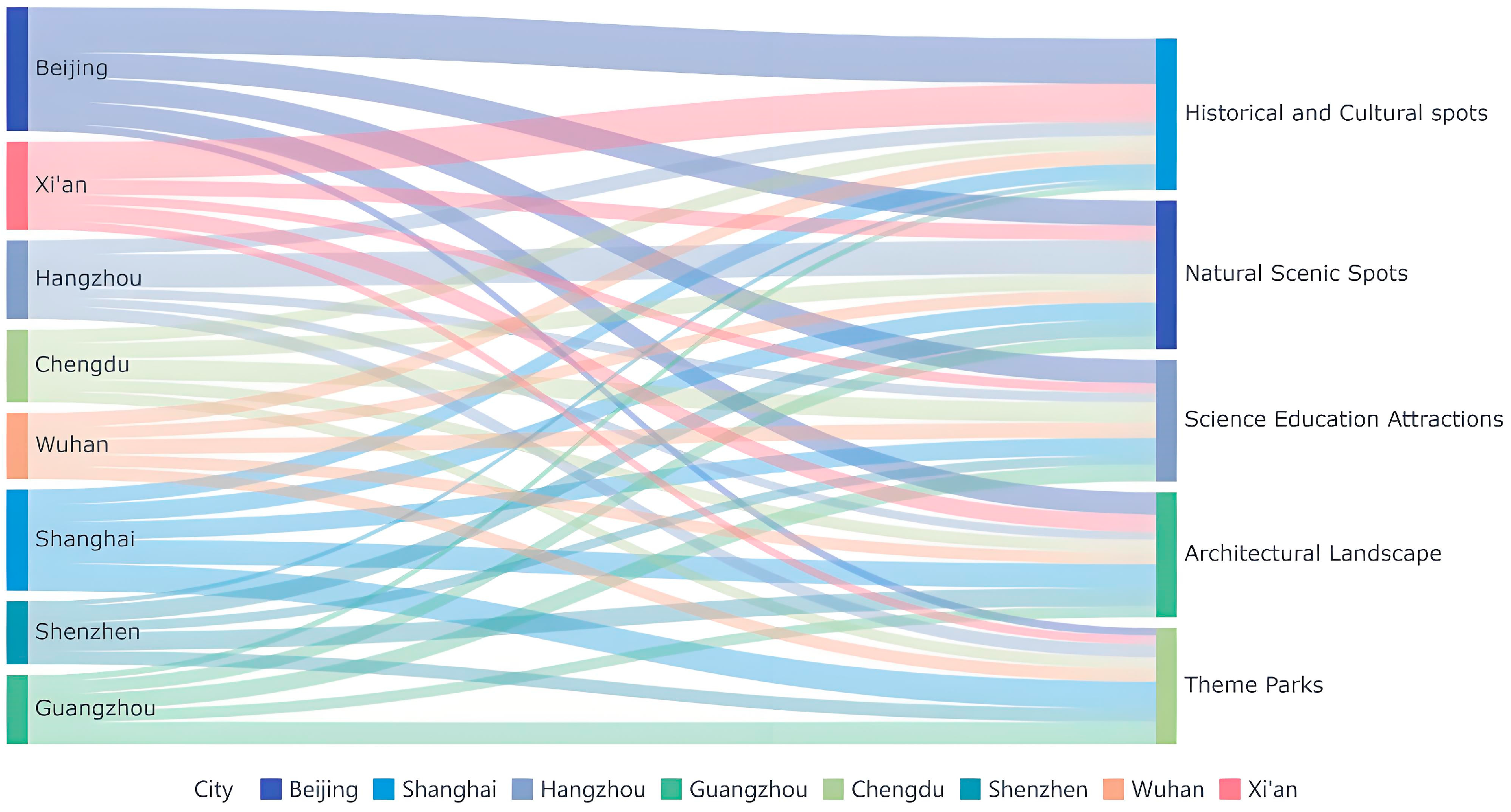
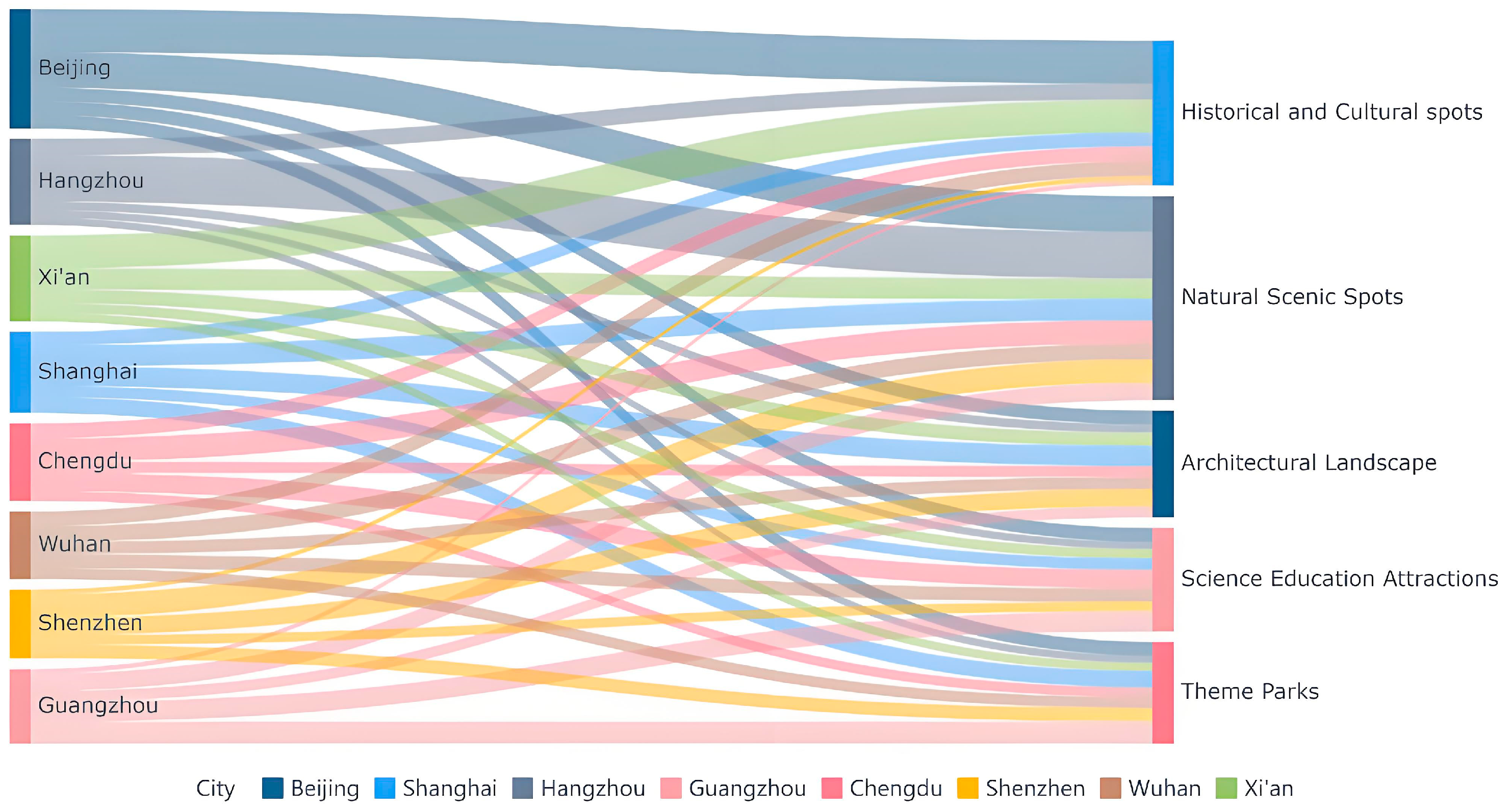

| Tourism Elements | Search Keywords |
|---|---|
| Catering | Food; Food Tips; Snacks; Specialty Snacks; Specialties; Restaurants |
| Accommodation | Lodging; Hotel; Hotel Reservation; Guest House; Resort; Agriturismo |
| Transportation | Airfare; Train Tickets; Airport; Train Station; Bus; Bus Schedule |
| Sightseeing | Travel; Travel Tips; Tourist Attractions; Fun Places; Driving Tours; Tour Groups |
| Shopping | Specialties; Shopping; Malls; Souvenirs; Tourist Souvenirs; Specialty Gifts |
| Entertainment | Entertainment; Leisure; Entertainment Venues; Shows; Nightlife; Bars |
| Number of Tourist Attractions with 4A and above and over 1000 Online Reviews | Number of Tourist Attractions Selected | Cities |
|---|---|---|
| More than 100 | 15 | Beijing, Shanghai |
| 70–100 | 10 | Hangzhou, Guangzhou, Chengdu |
| 40–70 | 8 | Shenzhen, Wuhan, Xi’an |
| Less than 40 | - | - |
| City | Pre-Epidemic | Epidemic Period | Post-Epidemic | ||||||
|---|---|---|---|---|---|---|---|---|---|
| Peak | Month | S | Peak | Month | S | Peak | Month | S | |
| Beijing | triple | Apr. Aug. Oct. | 1.401 | twice | May Sept. | 1.883 | triple | May Aug. Oct. | 2.283 |
| Shanghai | twice | Apr. Aug. | 1.769 | twice | Jul. Oct. | 1.092 | double | Apr. Aug. | 1.970 |
| Hangzhou | double | Apr. Aug. | 1.516 | double | Jul. Oct. | 1.619 | double | Apr. Jul. | 2.308 |
| Guangzhou | single | Aug. | 1.137 | double | Apr. Jul. | 1.216 | double | Apr. Aug. | 1.284 |
| Chengdu | single | Aug. | 1.009 | single | Jul. | 1.075 | single | Aug. | 1.803 |
| Shenzhen | double | Apr. Jul. | 1.183 | double | Apr. Jul. | 1.281 | double | Apr. Aug. | 2.562 |
| Wuhan | triple | Apr. Aug. Oct. | 1.080 | single | Jul. | 0.896 | triple | Apr. Aug. Oct. | 2.426 |
| Xi’an | double | May Aug. | 1.437 | double | Apr. Jul. | 1.518 | single | May Jul. | 1.954 |
| Type | Centre Point | Short Axis (km) | Long Axis (km) | Rotation (°) | Ellipse Size (km2) | Ellipticity | |
|---|---|---|---|---|---|---|---|
| Catering | Pre-epidemic | 115°93′ E, 30°86′ N | 787.6 | 901.6 | 85.01 | 2,229,758 | 0.126 |
| Epidemic period | 113°83′ E, 31°56′ N | 857.2 | 972.5 | 30.47 | 2,617,563 | 0.119 | |
| Post-epidemic | 114°05′ E, 31°77′ N | 849.1 | 940.3 | 27.94 | 2,506,994 | 0.097 | |
| Accommodation | Pre-epidemic | 114°84′ E, 31°03′ N | 840.4 | 1016.4 | 42.01 | 2,682,169 | 0.173 |
| Epidemic period | 114°80′ E, 30°98′ N | 875.3 | 1022.3 | 48.83 | 2,809,644 | 0.161 | |
| Post-epidemic | 114°34′ E, 31°00′ N | 854.2 | 1017.9 | 55.94 | 2,730,266 | 0.144 | |
| Transportation | Pre-epidemic | 114°52′ E, 30°38′ N | 827.3 | 977.5 | 9.43 | 2,539,221 | 0.223 |
| Epidemic period | 114°93′ E, 30°18′ N | 812.1 | 940.4 | 14.05 | 2,397,993 | 0.154 | |
| Post-epidemic | 114°75′ E, 30°18′ N | 798.8 | 1027.6 | 15.20 | 2,577,498 | 0.136 | |
| Sightseeing | Pre-epidemic | 113°60′ E, 31°57′ N | 865.9 | 935.9 | 26.87 | 2,544,706 | 0.075 |
| Epidemic period | 113°48′ E, 31°53′ N | 887.3 | 947.5 | 24.62 | 2,640,039 | 0.064 | |
| Post-epidemic | 113°86′ E, 31°15′ N | 874.5 | 951.0 | 21.35 | 2,611,452 | 0.080 | |
| Shopping | Pre-epidemic | 113°94′ E, 30°04′ N | 818.3 | 1005.9 | 11.64 | 2,584,422 | 0.187 |
| Epidemic period | 114°15′ E, 30°36′ N | 849.4 | 983.0 | 20.08 | 2,621,775 | 0.136 | |
| Post-epidemic | 115°04′ E, 30°06′ N | 774.9 | 947.2 | 16.55 | 2,304,822 | 0.182 | |
| Entertainment | Pre-epidemic | 114°23′ E, 30°29′ N | 761.5 | 946.5 | 14.77 | 2,263,087 | 0.195 |
| Epidemic period | 114°20′ E, 30°45′ N | 854.1 | 913.0 | 17.82 | 2,448,535 | 0.064 | |
| Post-epidemic | 114°18′ E, 29°92′ N | 761.5 | 946.5 | 10.01 | 2,263,087 | 0.195 | |
| Periods | Catering | Accommodation | Transportation | Sightseeing | Shopping | Entertainment | |
|---|---|---|---|---|---|---|---|
| Pre-epidemic | 2017 | 0.479 | 0.496 | 0.421 | 1.095 | 1.768 | 1.289 |
| 2018 | 0.474 | 0.481 | 0.478 | 1.059 | 1.617 | 1.091 | |
| 2019 | 0.451 | 0.469 | 0.467 | 1.002 | 1.435 | 0.896 | |
| Epidemic period | 2020 | 0.449 | 0.501 | 0.437 | 0.867 | 0.846 | 0.659 |
| 2021 | 0.473 | 0.521 | 0.459 | 0.995 | 0.776 | 0.753 | |
| 2022 | 0.476 | 0.496 | 0.423 | 0.732 | 0.689 | 0.709 | |
| Post-epidemic | 2023 | 0.515 | 0.507 | 0.498 | 1.473 | 0.918 | 0.825 |
| Periods | Beijing | Shanghai | Hangzhou | Guangzhou | Chengdu | Shenzhen | Wuhan | Xi’an | |
|---|---|---|---|---|---|---|---|---|---|
| Pre-epidemic | 2017 | 50.163 | 48.746 | 49.130 | 48.520 | 47.748 | 50.396 | 47.357 | 65.788 |
| 2018 | 52.657 | 55.732 | 54.673 | 49.574 | 47.561 | 56.672 | 48.720 | 63.473 | |
| 2019 | 50.647 | 58.528 | 57.709 | 48.850 | 49.320 | 60.071 | 47.502 | 62.777 | |
| Epidemic period | 2020 | 61.914 | 74.423 | 67.937 | 66.144 | 60.361 | 82.633 | 61.535 | 74.458 |
| 2021 | 54.657 | 76.240 | 69.238 | 70.397 | 60.647 | 90.886 | 65.122 | 74.102 | |
| 2022 | 60.916 | 94.713 | 75.362 | 78.569 | 67.130 | 118.906 | 78.135 | 87.622 | |
| Post-epidemic | 2023 | 54.716 | 61.281 | 59.338 | 62.701 | 55.418 | 70.402 | 57.804 | 62.893 |
| Type | Attractions |
|---|---|
| Natural Scenic Spots | Xiling Snow Mountain, West Lake, Xixi Wetland Park, Baiyun Mountain, East Lake, Huangpu River Cruise, Qiantang River, Yangtze River Bridge, Mount Qingcheng, Shenzhen Bay Park, Dameisha, Shenzhen, Mutianyu Great Wall, Badaling Great Wall, Dujiangyan Irrigation System, Pearl River Night Cruise, Hankou Riverside, Qiandao Lake; Rose Coast |
| Historical and Cultural Spots | Yuanmingyuan Park, Lingyin Temple, Temple of Heaven, The Palace Museum, Wuhou Shrine, Hubu Alley, Huaqing Palace, Big Wild Goose Pagoda, Leifeng Pagoda, Daming Palace, Terracotta Army, Da Tang Furong Garden, Prince Gong’s Mansion, Datang Everbright City, Shamian Island, Qinghefang, Yellow Crane Tower, Nanluoguxiang, Du Fu Thatched Cottage; Summer Palace |
| Architectural Landscape | Beijing National Stadium, Tiananmen Square, Shanghai City God Temple, Yu Garden, Shanghai, The Bund, Shanghai, Nanjing Road Walking Street, Jinli Ancient Street, Hangzhou Paradise, Xi’an City Wall, Wide and Narrow Alleys, Guangzhou Canton Tower, People’s Square, Window of the World, Tianzifang, Shanghai, Gubei Water Town; Oriental Pearl Tower |
| Science Education Attractions | Madame Tussauds Shanghai, Shaanxi History Museum, Shanghai Science Museum, Shanghai Museum, National Museum of China, Guangdong Museum, Shanghai Wild Animal Park, Beijing Wildlife Park, Chengdu Polar Ocean World, Haichang Polar Ocean World, Guangzhou Science Center, Jinsha Site Museum; Hubei Provincial Museum |
| Theme Parks | Shanghai Happy Valley, Chimelong Paradise, Shanghai Disney Resort, Chimelong International Circus, Wuhan Happy Valley, The Giant Panda Base, Chimelong Safari Park, Chimelong Water Park, Eastern Overseas Chinese Town, Shenzhen Happy Valley, Shenzhen Safari Park, Universal Studios BeijingSong Dynasty Town, Splendid China Folk Village, Beijing Happy Valley, Hangzhou Safari Park; Shanghai Aquarium |
Disclaimer/Publisher’s Note: The statements, opinions and data contained in all publications are solely those of the individual author(s) and contributor(s) and not of MDPI and/or the editor(s). MDPI and/or the editor(s) disclaim responsibility for any injury to people or property resulting from any ideas, methods, instructions or products referred to in the content. |
© 2024 by the authors. Licensee MDPI, Basel, Switzerland. This article is an open access article distributed under the terms and conditions of the Creative Commons Attribution (CC BY) license (https://creativecommons.org/licenses/by/4.0/).
Share and Cite
Sun, F.; Li, Z.; Xu, M.; Han, M. New Changes in Chinese Urban Tourism Pattern under the Impact of COVID-19 Pandemic: Based on Internet Attention. Sustainability 2024, 16, 5853. https://doi.org/10.3390/su16145853
Sun F, Li Z, Xu M, Han M. New Changes in Chinese Urban Tourism Pattern under the Impact of COVID-19 Pandemic: Based on Internet Attention. Sustainability. 2024; 16(14):5853. https://doi.org/10.3390/su16145853
Chicago/Turabian StyleSun, Fengzhi, Zihan Li, Mingzhi Xu, and Mingcan Han. 2024. "New Changes in Chinese Urban Tourism Pattern under the Impact of COVID-19 Pandemic: Based on Internet Attention" Sustainability 16, no. 14: 5853. https://doi.org/10.3390/su16145853
APA StyleSun, F., Li, Z., Xu, M., & Han, M. (2024). New Changes in Chinese Urban Tourism Pattern under the Impact of COVID-19 Pandemic: Based on Internet Attention. Sustainability, 16(14), 5853. https://doi.org/10.3390/su16145853





